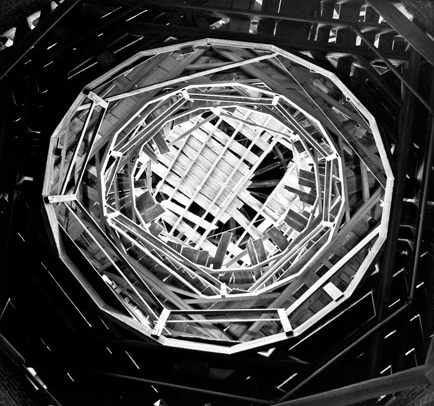Take a stroll through Exploring Photography as a few of our staff members explain their favorite pieces on display. Visit the museum to see these photographs in person through July 9, and share your favorites with us via social media by tagging your posts with #lsumoa.
Richard Sexton (American, b. 1954), Inner Rotunda, Longwood Plantation, 2008 (negative 2007), QPP, carbon-pigment digital print, ed. 1/25, Purchased with Funds from the Friends of LSU Museum of Art Endowment, LSUMOA 2011.5.2
There are a few reasons this photograph grabs my attention.
First, when I saw this photograph, it was only a thumbnail image as we were in the initial exhibition planning stages, so I didn’t quite know what it was that I was looking at. Drawing conclusions, it appeared to be an aerial photograph of some terrain or lake—I was pleasantly surprised to realize I was way off! This made me chuckle and smile.
Second, the light is incredible. If anyone knows anything about printing black and white, they know how important it is to capture that range of silver tones, and this is a wonderful example.
Lastly, I love lines. I look for lines in most work I view. I connect lines, I draw lines, I see lines and love to see what these lines will make.
—Brian Morfitt, preparator
Suda House (American, b. 1951), Kali Ma, from the “Aqueous Myths,” 1985 (printed 2016), chromographic print, A/P, Gift of the Artist, LSUMOA 2016.5.3
One of the photographs I'm most drawn to is Kali Ma from Suda House’s “Aqueous Myths” series, which explores women, feminism, power, and mythology. While researching this work and reading House's statement, which references her own fascination with rough-water swimming off the coast of California (available here), I also happened to be reading Lydia Yuknavitch's memoir Chronology of Water and was struck by the parallels between the works. House's image is inspired by the Hindu goddess Kali, destroyer of evil forces, and Ma for mother. As the Divine Mother, Kali Ma represents the duality often associated with female sexuality. House’s inclusion of a weapon suggests taking life, but the hatching dinosaur eggs suggest giving life. In Yuknativich's work (and life) swimming is a powerful activity and metaphor for Yuknavitch's own experiences around violence, sex, and motherhood.
—Courtney Taylor, curator
Robert von Sternberg (American, b. 1939), Los Osos, 2012 (printed 2016), inkjet print on Canson Infinity Baryta Photographique paper, Gift of the Artist, LSUMOA 2016.6.5
I’ve always been drawn to art that takes an everyday object or scene and forces you to look at it in a different way. This photograph by Robert von Sternberg is a perfect example of that concept. By using a centered composition, he is able to best highlight the symmetry of a bank of gas pumps and show depth through basic three-point perspective. This everyday scene is made more dramatic with the juxtaposition of dark, almost pitch black surroundings with bright, saturated lights, all elements we often overlook when rushing to get to our destination.
—Brandi Simmons, communications coordinator



